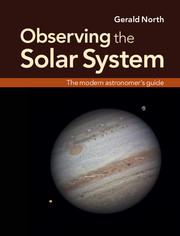Book contents
- Frontmatter
- Contents
- Preface
- Acknowledgements
- Chapter 1 Earth and sky
- Chapter 2 Moon and planet observer's hardware
- Chapter 3 The Solar System framed
- Chapter 4 Stacking up the Solar System
- Chapter 5 Our Moon
- Chapter 6 Mercury and Venus
- Chapter 7 Mars
- Chapter 8 Jupiter
- Chapter 9 Saturn, Uranus and Neptune
- Chapter 10 Small worlds
- Chapter 11 Comets
- Chapter 12 Our daytime star
- Appendix 1 Telescope collimation
- Appendix 2 Field-testing a telescope's optics
- Appendix 3 Polar alignment
- Index
Chapter 4 - Stacking up the Solar System
Published online by Cambridge University Press: 05 November 2012
- Frontmatter
- Contents
- Preface
- Acknowledgements
- Chapter 1 Earth and sky
- Chapter 2 Moon and planet observer's hardware
- Chapter 3 The Solar System framed
- Chapter 4 Stacking up the Solar System
- Chapter 5 Our Moon
- Chapter 6 Mercury and Venus
- Chapter 7 Mars
- Chapter 8 Jupiter
- Chapter 9 Saturn, Uranus and Neptune
- Chapter 10 Small worlds
- Chapter 11 Comets
- Chapter 12 Our daytime star
- Appendix 1 Telescope collimation
- Appendix 2 Field-testing a telescope's optics
- Appendix 3 Polar alignment
- Index
Summary
If you want to obtain images of the Sun, Moon and planets showing the very finest detail possible with your equipment in any given observing conditions then you have to put in just a little extra effort and go for a more sophisticated approach than taking single frames. The key to success is to find a suitably sensitive camera that is able to take a rapid-fire stream of images, one after the other. In generic terms, of course, this a video camera. It could even be a domestic video camera, though this would not be the best choice. In fact, almost any modern imaging device that takes video sequences known as AVIs (the letters stand for audio video interleave) can be used to take short video sequences of the Sun, Moon and planets. Please read and digest Chapter 12 before you even think of trying to image the Sun. The solar radiation collected and concentrated by a telescope is dangerous. There is the potential to blind yourself and/or burn yourself and/or damage property and equipment. You have to know what you are doing and take the greatest care when attempting to image the Sun.
THE BENEFITS OF STACKING SELECTED IMAGES
Before the late 1980s, the most successful way for an amateur astronomer to record fine details on the Moon and planets was to critically study the view through the eyepiece and make a drawing. The finest details on that drawing were gleaned from the occasional few flashes of fine detail that occurred during a session of something like 10 to 20 minutes long for drawing the planets, or maybe half an hour for sketching a small part of the Moon. It was almost impossible for the users of photographic film to get such detailed views because atmospheric turbulence usually blurred the image during the exposure. It was necessary to enlarge the image enough to resolve fine details but this dimmed it so much that the insensitive films of the day needed exposures of several seconds to properly capture it. The chance of the image staying sharp and motionless on the film for several seconds was practically zero.
- Type
- Chapter
- Information
- Observing the Solar SystemThe Modern Astronomer's Guide, pp. 95 - 120Publisher: Cambridge University PressPrint publication year: 2012



